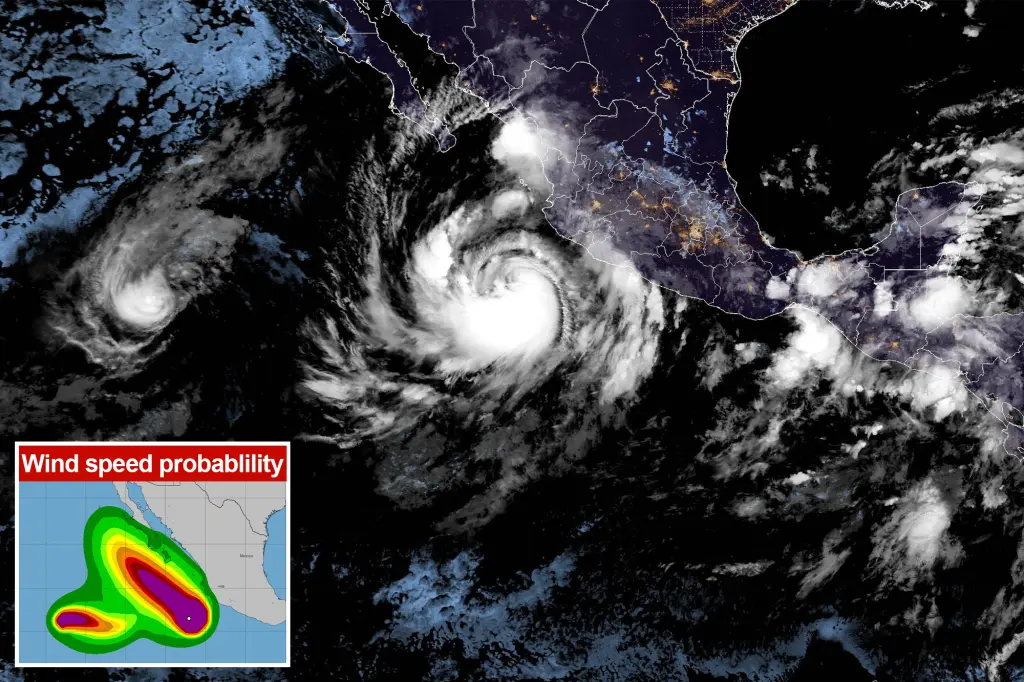Hurricane Priscilla Strengthens in Pacific, Threatens Southwest Mexico
Hurricane Priscilla gained significant strength late Sunday in the Pacific Ocean, posing a serious threat to coastal communities in southwest Mexico with its combination of heavy rainfall and powerful winds. The storm reached maximum sustained winds of 80 mph and was moving north-northwest at a slow 3 mph, according to the US National Hurricane Center in Miami. This relatively unhurried pace could potentially amplify the storm’s impact as it lingers near vulnerable coastal areas. Located approximately 260 miles south-southwest of Cabo Corrientes and 450 miles south-southwest of Baja California, Priscilla’s position put several Mexican states directly in its potential path, including Guerrero, Michoacán, Colima, and Jalisco.
As residents in coastal communities prepared for the approaching storm, authorities issued a tropical storm watch for a significant stretch of southwestern Mexico’s coastline, spanning from Punta San Telmo to Punta Mita. This alert warned locals that tropical storm conditions were expected to affect the region throughout Sunday and into Monday. The slow-moving nature of Hurricane Priscilla particularly concerned meteorologists, as lingering storms often produce more extensive flooding. Forecasters predicted substantial rainfall totaling up to 6 inches across the affected states, raising serious concerns about potential flash flooding in both urban areas and rural communities with limited drainage infrastructure. Local emergency management teams began mobilizing resources and communicating evacuation procedures for vulnerable neighborhoods in low-lying areas.
Even for areas not directly in Priscilla’s path, the hurricane generated ocean swells that threatened to create dangerous surf conditions and potentially deadly rip currents along the coasts of southwestern and western Mexico, extending to southern Baja California. These secondary effects of the hurricane posed significant risks to beachgoers, fishermen, and coastal residents who might underestimate the storm’s impact beyond its immediate landfall zone. Coastal hotels advised tourists to avoid ocean activities, while local fishing operations temporarily suspended their work in anticipation of hazardous maritime conditions. The Mexican Navy increased its monitoring of coastal waters and prepared rescue teams in case recreational or commercial vessels encountered difficulties.
Local authorities in the potentially affected Mexican states implemented their emergency response protocols, with particular attention to communities with limited resources or difficult access. They established emergency shelters in schools and community centers, positioned water and food supplies in strategic locations, and prepared medical teams for potential injuries or health issues resulting from the storm. Past hurricanes in this region have demonstrated how quickly flash floods can develop in Mexico’s mountainous coastal terrain, where heavy rainfall can quickly funnel through canyons and valleys into populated areas. Community leaders worked with government officials to ensure vulnerable populations, including the elderly and those with limited mobility, had transportation to safer locations if evacuations became necessary.
Meanwhile, further out in the Pacific Ocean, Hurricane Octave also formed on Sunday, reaching wind speeds of 85 mph. Unlike Priscilla, however, Octave posed no immediate threat to land, with forecasters predicting no coastal impacts and issuing no watches or warnings related to this second storm. The hurricane was expected to begin gradually weakening by Monday as it moved over cooler waters and encountered less favorable atmospheric conditions. While meteorologists would continue monitoring its development, the primary focus remained on Hurricane Priscilla and its potential impact on Mexican coastal communities.
The dual hurricane development illustrated the particularly active nature of this year’s Eastern Pacific hurricane season, challenging emergency management resources across the region. Climate scientists note that while the connection between climate change and hurricane frequency remains complex, warming ocean temperatures do contribute to increased storm intensity and rainfall amounts. For residents of southwestern Mexico, the immediate concern remained preparing for Priscilla’s arrival – securing loose objects around homes and businesses, stocking emergency supplies, staying informed through official weather updates, and following evacuation orders if issued. As the storm approached, both government agencies and humanitarian organizations stood ready to provide assistance to affected communities, with hopes that advance preparation would minimize the hurricane’s human impact even as its environmental effects remained unavoidable.











